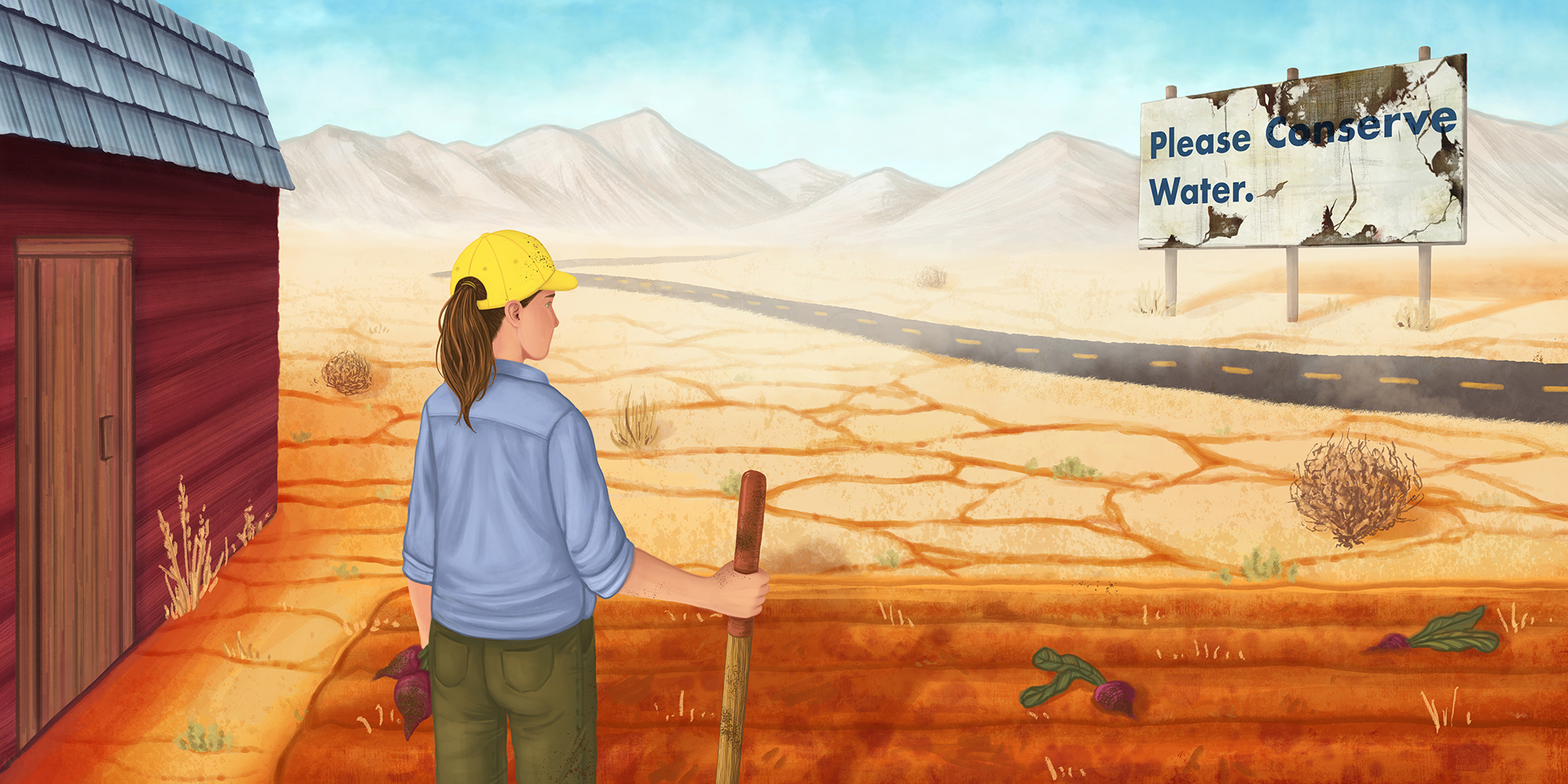When climate change enters the chat
Climate change presents a slew of challenges for the farmers of California, reports Jude Coleman. Illustration by Anh Kim Loc.

Illustration: Anh Kim Loc
Kirsten Yogg wears faded leather boots as she picks her way across the fields of University of California, Santa Cruz’s Agroecology Farm. Each step crunches into the dry, caked mud. Weaving between patches of sprawling vetch, fiery calendula and spindly yellow mustard weed, she pauses to kick a few times at the ground. It doesn’t budge. “The ground is so dry I can’t get a shovel in,” she says. In Januaries past, she would be waiting for the ground to dry out—not thinking about firing up the irrigation system. Adjusting her hat, a yellow ball cap with “Food What?!” emblazoned across the front, she leads the way through the 30-acre farm.
As Yogg prepares UCSC’s fields for spring, one hurdle she takes into consideration is irregular wet-dry patterns. A bone-dry January 2022 followed several intense rainstorms this year, as opposed to the steady, predictable winter-long rainfall of decades past. It’s just one of many complications global warming has created for farmers like her. To continue feeding the planet, farmers will need to adapt not only to the drought and heat brought on by climate change, but to a change in the seasons as well. Climate change is currently tricking the planet into earlier and earlier springs, stretching out the Earth’s growing window. For folks like Yogg, the earlier springs could mean a longer growing season—which may prove to be an unmet opportunity for agriculture. But the shift in ecology may impact more than just crops and the people growing them. Animals or insects that depend on the plants could also be left in the lurch, too.
A Bushel of Bummers
The consequences of climate change are impossible to escape. Global warming caused by industrial emissions and human activity is ripping its way through the environment. In the face of these effects, farmers are confronting a myriad of challenges—and the flavor of those challenges change depending on where a farm is located. Across Oregon and Washington, farms have begun to endure summer heat waves that render the fields too hot to work in. Record breaking, triple-digit temperatures in 2021 forced workers indoors, while tender leafy greens burned in the heat. The extreme inferno tragically claimed the life of a Willamette Valley farmworker, prompting policymakers to critically rethink safety regulations.
In California’s Central Valley, the limiting factor is water. Severe drought brought on by global warming has reduced access to water to the point of crops failing; across the valley, grapes turn to raisins beneath the sun, while farmers rip out almond orchards in parched defeat. Throughout the state, almost all of California’s water reservoirs have dipped below their historical levels, according to the California Department of Water Resources.
On California’s Central Coast, Yogg faces yet another problem: erratic weather. Though Santa Cruz’s typical, mild temperature range of 50°F to 80°F has remained, the consistency of precipitation is fading. When she first moved to the area in 2005, “It was very clear what the rhythm of the season was,” she said. In October, thirst-quenching rain would blanket the Bay Area, slowly petering out around March. “April is when we would be checking our soil for moisture, to see if it had dried down enough to till,” says Yogg. But now, patterns are changing. The cover crops blanketing each bed, meant to hold in moisture and keep out weeds, are getting thirsty. A row of beets is sprouting weeds, which Yogg leans down to yank, snagging several purple gems in the process. Lamenting, she sighs, “I don’t usually have to weed my beets in January.”
Yogg refers to these changes cumulatively as climate chaos. Here in the San Francisco Bay Area, the fluctuations in rain are wreaking more havoc than high temperatures. Studies from MIT and UCLA predict that extreme rain events in California will only become more likely as the climate evolves. Sudden, heavy rains following extended dry periods pummel the soil, creating the hard, impenetrable crust that defies Yogg’s shovel. Farmers are forced to till their fields more intensively, which reduces the soil’s health. The seared soil also struggles to absorb water quickly, so powerful rains wash away the dirt, eroding fields and causing landslides.
For all its fury, global warming is influencing one agricultural factor that may actually benefit some: the length of the growing season. Increased temperatures have been slowly but surely pushing forward the hands of nature’s clock, encouraging spring to begin earlier, and winter to creep in later.
On one hand, a longer growing season may appeal to farmers growing quick-to-harvest crops, like salad greens. Extra time could mean the opportunity for “double cropping,” says Pam Knox, an agricultural climatologist at University of Georgia. Double cropping means two crops can be planted back-to-back within the same growing season, allowing for two harvests instead of one. In the same vein, it may allow for successive cropping, when one crop is harvested and a different one immediately planted in its place. Extra crops mean higher yields and better profits for farmers, whose margin for return is already slim.
“But it’s also a longer growing season for pests and disease,” cautions Knox. In South Georgia last year, cotton from the previous season started regrowing after a short winter. Normally winter temperatures knock out the pests that thrive in cotton’s puffy plumage, but not this time. The resurging cotton fields acted as a host, welcoming pests back earlier. “Now [farmers] are going to have to use other means of controlling them,” she said, “like adding more insecticides or pesticides.”
But growing year-round robs the soil of a chance to regenerate, Yogg points out. Constant use doesn’t give microbes and nutrients a chance to refresh. Additionally, more plants need more water—a major drawback in drought-ridden states like California. Although the drier weather may allow for earlier planting, the extra water cost and unpredictability of precipitation is a major trade-off.
“It feels chaotic. I don’t know if I’m going to get a crop of apples; I don’t know when I should do the things that I need to do to manage pests.”
The capricious weather and longer season prove to be confusing to fruit trees too. Any tree that produces fruit must first produce a flower, whether it bears apples, citrus or almonds. Flowering trees are vulnerable to unpredictable weather: They will only put out blossoms once, and if those blossoms are nipped by a late frost, no fruit will follow. To avoid the repercussions of losing flowers, trees depend on “chill hours” to tell them when the danger of frost has safely passed. Instead of waiting for cues like warm weather or rain, they depend primarily on racking up time spent in the cold to signal that enough winter time has passed. It’s unclear how fruit trees will adapt as their time-keeping mechanics are rearranged, but the warm weather is confusing for them, confirms Yogg. “It feels chaotic. I don’t know if I’m going to get a crop of apples; I don’t know when I should do the things that I need to do to manage pests.”
Passing by the orchard at UCSC, Yogg pauses in front of some gnarled, barren apple trees. She gestures with a fistful of beets toward trees near the back, and says, “Some trees didn’t even drop all their leaves this year.” Hanging on by a thread of a stem, patches of last year’s foliage hang from branches like crumpled, mottled tissues.
The Global Mosaic of Shifting Patterns
At University of California, Santa Cruz, Ph.D. student Yiluan Song has been studying the way seasonal changes of plants—called phenology— are following the trends of global warming. Phenology applies to any organism’s cyclical, typically seasonal, change: Leaves bud out in spring, then they die and fall off when the temperatures drop; birds fly north in the summer, then they migrate south in the winter. Using satellite imagery, Song created a global comparison of the arrival of leaf buds with established global warming trends. In this comprehensive dataset, Song and her team were able to detect a mismatch in some areas between phenological changes and warming temperatures. Particularly in human-altered landscapes, like agricultural land, the onset of spring isn’t speeding up as soon as anticipated, given the warmer temperatures.
Understanding how warming trends move is a bit like looking at a topographic map, explains the study’s senior author, Kai Zhu, an ecologist at UCSC. Imagine the lines on a map that indicate a change in altitude. They connect the places that share the same elevation; for example, surrounding a mountain, they circumnavigate the peak in concentric circles, a new line added for each new value. A similar effect can be created when mapping temperature, except instead of lines connecting similar elevations, they connect similar temperatures. These lines are called isolines.
Song wanted to see how changes in phenology were tracking those isolines as they move. As temperatures rise globally, a shift in plant phenology toward earlier springs and later autumns is to be expected. Anecdotally, it’s something many people have witnessed; like cherry blossoms popping out in January, or an absence of crimson leaves well into the fall. The team compared the anticipated onset of spring—based on the increased temperatures—with the time that spring actually arrived. In the undisturbed wild, the first hints of green (known as green-up) appeared roughly when warm spring temperatures arrived, a little earlier than they used to. “At first, I was surprised,” said Song. “The wildlands are doing very well in keeping up with climate change.” But in pasture and crop land, there was a significant lag: Spring crops are sprouting later than expected, given the warmer weather. The difference is so pronounced on the map, that “We can kind of just draw out the boundary of croplands,” said Song. “It’s so obvious.”
One way scientists can monitor the change in global temperature is by tracking how isolines move. As the planet warms, the isolines are moving northward, indicating that warmer temperatures are inching toward the north pole. Generally, the planet follows a south-to-north temperature gradient, explains Zhu, meaning that the farther north you travel, the colder it gets. The northward movement of these isolines confirms that previously cool places will be heating up.
Why agriculture hasn’t yet caught up fully with this movement isn’t clear. It could be that the variety of crops growing are affecting the onset of leaves; Song suggests recent crop shifts from wheat and oats to corn and soybean in the midwestern U.S. could be reflecting a lag, because corn and soybeans sprout later. Or, it could just be that farmers are controlling when seeds go into the ground. Running on their own calendars, based on a multitude of factors, farmers dictate the timeline of the plants they raise. Their crops aren’t subject to the same timing that wild plants are.
“We have plans, and we have schedules, so adapting just takes a minute,” says Yogg. Deciding when to till the ground and start irrigating are integral moments on a farmer’s calendar. Their onset will change over time as Yogg adapts to climate chaos.
Rain also plays a big role in phenology, notes Knox. The right balance of moisture in the ground encourages plant growth. And, like Yogg explained, farmers are usually playing a waiting game for fields to be dry enough after winter precipitation. Soggy soil can’t be tilled or worked. So even though temperature dependent factors like frost danger affect sowing dates, it could be warmer weather alone hasn’t been enough to avail fields earlier.
Rippling Through the Environment
It’s not just farmers and their crops who will struggle with the season shifting, though. As the sturdy base of Earth’s trophic pyramid, plants—including crops—are connected to the entire ecosystem. A change in the base of that pyramid acts like a child pulling Jenga blocks haphazardly from a tower: The surrounding web of life could be destabilized, says Song. An understanding of the ripple effect that may come from earlier springs, both in wild and altered landscapes, is just starting to emerge. With flowers unfolding at different times, pollinators may become out of sync if their phenological cues misaligned with their floral partners—reducing pollinators’ viability and the fertility of the plants they visit. Birds could be particularly sensitive to this change, as their migration is based more on sun angle than temperature. Arriving back from their winter digs, they may find that they’ve missed the window of opportunity to feed on early-season fruits.
The questions surrounding phenological shifts merit more research to inform conservation decisions, the team says. Zhu says another factor to explore is how the urban heat island effect—the extra warmth that radiates from cities’ concrete—impacts plant phenology. Their remote sensing wasn’t able to detect specifics from these areas. Song plans to employ more detailed methods to explain phenological mismatches, and develop a plant phenology forecasting system. She hopes this could predict when plants’ phenological shifts will begin, to help the public manage things like allergies. For now, though, farmers like Yogg hang in the void between two chapters of Earth’s history: On one side, leaving behind the predictability of a climate pre-global warming; on the other, stepping into the unknowns of a longer season.
“We will see that farmland turns to deserts and that we will have issues growing enough food for the world,” says Yogg, tilting the brim of her yellow cap against the glare of mid-winter sun. “We need to be able to adapt to the harm that we’re creating.”
© 2022 Jude Coleman / UC Santa Cruz Science Communication Program

Jude Coleman
Author
B.S. Biology (botany/environmental science emphasis) Northern Arizona University
Internships: The Santa Cruz Sentinel, Inside Science News Service, Nature, NASA Earth Science News Team
While rummaging through a box of childhood relics, I recently unearthed a notebook from my youth. Within its pages, furiously scribbled chapters of a sci-fi novel depicted a dystopian, volcanically ravaged world, and the heroic young scientist that rebuilds it. I once dreamed of being the main character—making a difference as a hands-on part of the action. That led me to work as an environmental scientist and a horticulturist, and to research fungal pathogens.
But soon I realized my role in our future isn’t as the main character. I don’t want to spearhead healing a dying planet; I won’t be the one that develops Dune-inspired botanical technology or mycological vaccines. Instead, I find myself returning to my storytelling roots. I am no longer a character in my book, but the author—a science journalist imparting the facts and the inspiration needed to move forward in our dynamic world.

Anh Kim Loc
Illustrator
B.S. (biology, minor in art) California State University, Monterey Bay
From an early age I enjoyed learning about life whether in a garden, a forest, a farm, an aquarium, a market – it could be anywhere. Every time I go outside there is somewhere new to explore and something new to discover. Being a doodler allows me to record these observations from my surroundings and provides a creative outlet to express ideas and share experiences. Although I’ve tried out a variety of art mediums and studied biology, I tend to lean towards painting in watercolors and find myself fascinated with more playful and whimsical subject matters. I’m very thankful for my family for all the encouragement and support they’ve given me over the years.